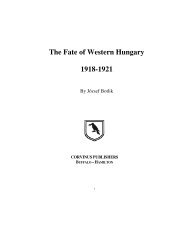The Tsangos of Romania - Corvinus Library - Hungarian History
The Tsangos of Romania - Corvinus Library - Hungarian History
The Tsangos of Romania - Corvinus Library - Hungarian History
You also want an ePaper? Increase the reach of your titles
YUMPU automatically turns print PDFs into web optimized ePapers that Google loves.
This is what he answered: "<strong>The</strong>y are not one nation since theirspeech, clothing differs from village to village, their number issmall and, I believe, they were <strong>Hungarian</strong>ized by the priests inMoldavia." This was a theory taught by the Rumanians who,we know have distorted quite a bit <strong>of</strong> their history. <strong>The</strong>y teachthat the <strong>Hungarian</strong>s in <strong>Romania</strong> are Rumanians but were<strong>Hungarian</strong>ized.With this statement they legalize all that they are doing to the<strong>Hungarian</strong>s.In the seminary <strong>of</strong> Bakó, students speaking <strong>Hungarian</strong>are not really admitted, the priests there prefer students fromvillages where <strong>Hungarian</strong> is no longer spoken and the trace <strong>of</strong>their being a Csángó, can only be detected in theirpronounciation <strong>of</strong> the letter "s". In Bakó, after one <strong>of</strong> themasses, the priest asked money from the people to help the poorChinese who were living under bad conditions. <strong>The</strong> priestasked for 250 lejs from those who wanted to help and 500 lejsfrom those who also wanted to have a picture <strong>of</strong> the person theywere helping. Many <strong>of</strong> the <strong>Hungarian</strong>s helped, even though,they were just as abandoned and in trouble as the Chinese.Pál Péter Domokos, also received a letter from one <strong>of</strong> thevillages, where two young boys wanted to become priests. <strong>The</strong>village did not want to send the boys to Bucarest or Iassi wherethere are seminaries, because they were afraid that there, amongthe Rumanians, they would forget their mother tongue. As theCsángós are in need <strong>of</strong> <strong>Hungarian</strong> priests they did not wantthese boys to become Rumanian priests so they asked the help <strong>of</strong>Pál Péter Domokos to send these boys to a <strong>Hungarian</strong>seminary.<strong>The</strong> clothing <strong>of</strong> the Csángós are all made by the women.<strong>The</strong> designs <strong>of</strong> these clothes not only betray the village wherethe person wearing it comes from but, also wheather the personis a young girl, a bride, a woman with children, or an oldwoman. When the girls marry, a wooden circle is braided intheir hair and on that a shawl is placed which can never be taken<strong>of</strong>f.In the church <strong>of</strong> Dioszin, there is a legend about a crosswhich was carved by a man who after finishing it took it to thepriests for him to bless it, he, seeing the primitive cross said thatif this was what Jesus looked like he would rather not be saved.On hearing this, the man gave the priest 20 lejs and only then,did he bless the cross which is still in the church today.
















